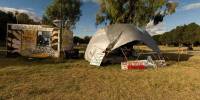
Aboriginal Tent Embassy, Parliamentary Triangle
Canberra, Australia
March 21, 2006, 5.45pm (UTC 0645)
© 2006 Norman Peters, All Rights Reserved.
You can see the main Tent Embassy structures, the sacred fire lit as part of a fire ceremony for peace in 1998, and across the road, the old provisional federal Parliament House. This panorama was shot the day after the biggest cyclone to ever hit the mainland - Larry, a Category 5 storm - destroyed the Queensland town of Innisfail, and just about the entire Australian banana industry. The the local gusts were blowing the embassy's soft structures around viciously. If you look closely you can see a yellow plastic boomerang lying on the lawn between the camera and the two 4WDs.
The Tent Embassy protest, located in the heart of the Australian federal parliamentary triangle area, may itself now be under threat. In late 2005, the federal Minister for Territories forecast that the end of the Aboriginal tent embassy in Canberra was near. In place of the existing protest, he proposed a permanent, organised interpretive display, that would end the long standing protest.
The Tent Embassy was erected on the lawn outside Parliament House in Canberra on Australia Day in 1972 as a protest in response to an Aboriginal policy statement by the Prime Minister, in which he announced his government's Aboriginal policy. There was no admission that Aboriginals had any right to land or compensation, because land rights would threaten the security of tenure of every Australian. Aboriginal communities were to be granted only special purpose leases if they could demonstrate adequate economic or social use for them. Mining was to be allowed on Aboriginal reserves. The protest was called an embassy to symbolise the feeling of many Aboriginal people that they were foreigners in their own country so long as they had no legal freehold title to any part of Australia.
This long-standing situation was at least partly addressed with the Native Title Act of 1993, however in 1998 the government amended the Native Title Act in a way which again makes it harder for indigenous groups to register claims, and which transfered extensive control of the operation of the Act from the Commonwealth Governments to the States. In so doing, it allowed the States to unilaterally extinguish Native Title to lands held under a wide range of categories.
It seems clear to me that the borders between indigenous Australia and the Federal Government are as well defined as ever...
Australia - New Zealand / Australia
Lat: 36° 19' 5.1" S
Long: 149° 7' 48.5" E
Elevation: 580 meters
Precision is: Unknown / Undeclared.


 Tap or click the zoom icon in the bottom right corner of the picture to switch between in-page and fullscreen view
Tap or click the zoom icon in the bottom right corner of the picture to switch between in-page and fullscreen view